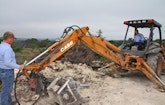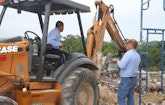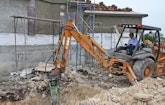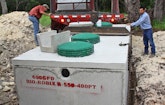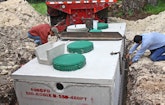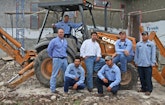
Interested in Systems/ATUs?
Get Systems/ATUs articles, news and videos right in your inbox! Sign up now.
Systems/ATUs + Get AlertsIn a booming regional economy, Paul Swoyer Septics has tapped into a limitless market with innovative construction, compensation and marketing.
An upscale, high-value market for 4,000- to 20,000-square-foot homes provides this area installer, based in Canyon Lake, Texas (near San Antonio) with opportunities as broad as the horizon. Here, Paul Swoyer enjoys conditions found in few other localities.
Building systems matched to outsized homes and the lifestyles makes Paul Swoyer a sought-after contractor. “I love to go to work,” says Swoyer, who has worked in the area for eight successful years.
Swoyer has pioneered an unusual approach to installations that, combined with local opportunities, brings better-than-average paydays to his employees and his bottom line. “We are focused,” Swoyer says. “We excel at certain things – our areas of strength – and will not go outside these areas.” To do so would reduce his efficiency and earnings. It is not a matter of what his crew can do; it is about what they can do best.
Toward strength
“I am not a septic guy,” says Swoyer. “I am not an operator. I am not an installer. I am not a maintenance provider.” His success flows from business acumen, not an understanding of system microbiology. Of course, he can do the work, and explain to a homeowner how the components interact to produce a well-treated effluent.
“After recovering from a car wreck, I worked for my brother-in-law’s installation business as a day laborer earning $50 per day,” Swoyer says. “For him, for two years, I did every task that needed to be done.” This gave him insight to what must be done – along with when, why and how – to complete a successful installation.
In November 2003, Swoyer set out on his own. His goal was to build a successful enterprise based on his understanding of the onsite business. He sees himself as a businessman rather than an onsite guru. “The successful guy will be the one with the better network of industry contacts, not the guy with the nicest, newest or most varied equipment inventory,” Swoyer believes.
Today, 75 percent of his business comes from new residential systems on virgin sites and 10 percent from complete replacement systems. The balance comes from repairs, inspections for property sales, and installation of commercial systems.
Controlling costs
Part of being a businessman is watching the dollars. “I take every discount I can get,” he says. “It benefits everybody – me, the vendor and my customer.” He earns discounts by paying bills promptly and buying items in volume. That way, when a special request arrives or a project calls for expedited delivery, the vendor will step up.
He used to buy tanks from multiple vendors, but he found that by consolidating all of his purchases with one, he receives better pricing and service. He asked all precasters to quote for his entire array of needs for a year. They showed their appreciation by offering lower prices.
Twice a month, on the first and 15th, he pays in full every invoice for materials, supplies or services. This helps him qualify for the most generous discounts and welds relationships. Component makers and precasters refer business to Swoyer because they can count on him for top-notch, next-day service. Swoyer patronizes those who reciprocate with loyalty and referrals – and loyalty matters more than price.
Where customer relationships are concerned, Swoyer is big on first impressions – and on billboards, literally and figuratively. In his service area are at least 10 billboards along major highways listing his personal cellphone number. “I want to be the first person to talk to a potential customer,” says Swoyer. “I am a call screener.” He then directs calls to the appropriate person on his team, usually office administrator Marisa Kane.
Long before their systems are installed, customers understand what they will be getting and Swoyer’s operation and maintenance obligations. The state requires a two-year maintenance agreement, included in the purchase price.
“It’s important that customers know what to expect and who to call if troubles arise,” says Swoyer. “Every one of our systems comes with a three-year maintenance agreement.” The incremental cost for the extra year is a fraction of the value of the entire job, and it is an easy, customer-friendly way to add value without adding work.
Strategic choices
While many build system maintenance and management businesses as regulatory requirements spread, Swoyer chooses not to – he values peaceful weekends and holidays without emergency calls. “I’m perfectly happy leaving the management work to my vendors,” he says. “They have the skills and understanding. Not doing management lets me focus on installation.”
Installations can be challenging enough. Systems in his territory are often installed in conditions some would consider unsuitable. “The excavation for nearly every treatment tank we install must be hammered into the hard native limestone,” says Swoyer. “Each of our excavating machines has a hydraulic hammer for that purpose. Usually, the hole for the tank can be cut out in about five hours, but if I see that we can’t keep on schedule because of highly resistant rock or other issues, I’ll rent the necessary equipment and operator to ensure that we stay on schedule. That frees my skilled employees for more critical tasks they are better suited to perform.”
For absorption areas on a leveled rock surface, Swoyer uses sandy loam, drip tubing, more loam and a cover layer of suitable soil. He can install a complete system in about three days. When advanced treatment is needed, his system of choice is the BioRobix B-550 aerobic treatment unit (Enviro-Flo).
Swoyer analyzes every detail of every job for its contribution to a successful and cost-effective installation. Faced with the choice of sowing grass seed on a completed system or placing sod, Swoyer chooses sod every time. Grass seed, he believes, is too unpredictable.
Different drummer
Swoyer says that his success comes in part from understanding who his boss is: “The customer is my boss. Our best customers and loudest advocates are the customers who were the most challenging to satisfy. We are the most expensive installer in this marketplace, yet we are the most sought-after as well. Our quoted price is the final price. Customers appreciate the certainty and peace of mind that a guaranteed price and an extra year of maintenance provide.”
Owners of large homes, while not frivolous spenders, are willing to pay for systems designed to meet their lifestyles and expectations. Even Swoyer’s employee pay scale is unique in an industry noted for hourly pay or a fixed salary.
“We pay our employees based on the task,” he says.” Hammering a tank hole, installing a drip field, and sodding an otherwise complete site each have assigned values.” An employee who finishes a hole in three hours can go home – his day’s work is done; his skill and proficiency have earned a kind of bonus. If the hole takes longer, the worker stays until the job is done.
The company’s equipment includes Case 580 tractors with Tramac 300 hammers, a Case 440 skid-steer, a Bobcat T300, and an RT 560 rock saw (River City Mfg.). A fleet of Ford F-250 and F-350 trucks is available as needed. The company provides employees with all heavy equipment and covers all routine maintenance and operating costs.
Damage is another matter: Employees know there is a shared responsibility. “We sometimes see new, eager employees push the equipment beyond its limits,” Swoyer says. “When they break it, we split the repair cost 50/50.” He believes this arrangement builds employee-business partnerships.
Swoyer divides employees into two groups: office/administrative and installation. The installation team members are fully cross-trained and can do all tasks that go with a project. Swoyer and three other workers sell and support the nine-person field crew.
Lasting impressions
Putting customers first leaves a lasting impression. Swoyer nurtures each first contact into a part of his growing network of friends, advocates, colleagues, collaborators and customers. He treats competitors as resources and allies rather than opponents.
Swoyer puts others’ needs ahead of his own, using a business model he built from the ground up. By choosing to put himself last, he has put himself first in his chosen industry.

